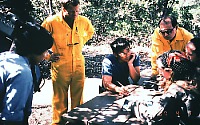
|
|
The Hawaiian Volcano Observatory (HVO) enjoys a world-wide reputation as a leader in the study of active volcanism. Due to their usually benign natures, Kilauea and Mauna Loa, the most active volcanoes on the Island of Hawai`i, can be studied up close in relative safety. While observations made by 19th-century missionaries and travelers constitute a large part of the early and colorful history of volcano watching in Hawai`i, HVO's origins are rooted in a desire to use scientific methodology to understand the nature of volcanic processes and to reduce their risks to society.
What We Do
HVO is part of the Volcano Hazards Program of the U.S. Geological Survey. Our staff conducts research on the volcanoes of Hawai`i and works with emergency-response officials to protect people and property from earthquakes and volcano-related hazards. We work to reduce the risks from these hazards in the following ways.Knowledge of past eruptions and earthquakes, and careful monitoring of ongoing activity, form the basis of our current hazard assessments in Hawai`i and our studies of volcanic and seismic processes. By keeping abreast of what is happening, and by knowing what has happened, we can coexist with Hawai`i's active volcanoes, living, working, and playing on them and minimizing their dangers to people and property.
Our current work is focused on the following subject areas:-
 Gas geochemistry
Gas geochemistry
- Geophysics
- Ground deformation
- Geology
- Seismology
History of the Hawaiian Volcano Observatory
HVO has a long and complex history, much of which was summarized by Russell Apple, retired National Park Service historian, to celebrate the 75th anniversary of its founding by Thomas Jaggar in 1912. Russ has kindly given us permission to quote in full his historical essay, which appeared in USGS Professional Paper 1350, a collection of mostly technical papers about Hawai`i published in 1987 and edited by Bob Decker, Tom Wright, and Peter Stauffer.Russ' essay stands out in its accuracy and readability, and we recommend it to anyone interested in understanding the flavor of HVO, particularly during the first half of the 20th century.
Tribute to a friend and colleagueReggie began his career at HVO as a Physical Science Technician in 1958, after receiving a degree in entomology, with a minor in chemistry, at the University of Hawaii at Manoa. In 1978, he became Chief of Operations, a position he held until his retirement in 1992. |
Other USGS Volcano Observatories
-
 Alaska Volcano Observatory (AVO)
Alaska Volcano Observatory (AVO)
- USGS Cascades Volcano Observatory (CVO)
- Long Valley Observatory (LVO)
Volcano Monitoring Strategies
Descriptions, photographs, graphic illustrations, and case
examples of scientific methods used to monitor volcanoes.
![]()
Contact: hvowebmaster@usgs.gov
Updated: 18 June 2001 (pnf)







